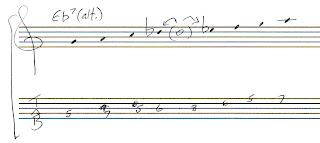There's an idea I've been fiddling with ever since I dug it out of Johnny Hodges' "Double Check Stomp" solo (with Duke Ellington, 1930) twenty years ago. Here's the tune - Rabbit is the second soloist, between Artie Whetsol and Tricky Sam Nanton.
There are a few reasons why I find this so fascinating: First and most importantly, Hodges' solo is (as usual) scintillating. But from an analytical standpoint, I find very elegant the idea that you can start off in a major pentatonic scale, and express all the changes through half-step shifts of one note or another in the original scale. There are three ways in which he seems to do this: moving a note up or down a half step, or collapsing two notes a whole step apart into the semitone between them, which occurs at the end of the bridge, where Eb and F "become" E-natural (there are two other permutations as well, which I'll get to anon).
This analysis also seems to vindicate my long-held observation that the primary motivation in the vast majority of (good) jazz solos is tonality, particularly the home key of the tune, and that the whole Jamey Aebersold "scales and modes" approach to improvisation is utter bullshit. Of course you have to be able to address the changes, but it's my contention that the tonality of the tune will inform how one does that (more on this in the future).
So what's this got to do with the banjo? I have a gig tomorrow where I have a banjo solo on "Night in Tunisia" and feel like I need to rethink the whole thing. Here's the bare bones of my usual approach to it, which I don't recall having set the jazz world alight any of the last 20,673 times I've played it (mostly on bass):
Eb7 (Bb melodic minor) Dm (D-minorish/blues stuff); 2 more of those, then Em7b5 -A7 (pretty much D harmonic minor); Am7b5 - D7 (G harmonic minor) Gm (G minorish/bah-looz stuff); Gm7b5 - C7 - F (pretty much the same thing but in F minor and major); A7 (whatever)….
It probably doesn't help that I've never really been crazy about "Night in Tunisia," ever since the time back in the 70's when a quartet I was in was playing a reception for Ray Charles and his band downstairs at The Mosque in Richmond after his concert there. Ray never showed up as I recall, but his band did. His WHOLE band, all with their axes, all dying to sit in and stretch out a little, which they all did, during "Night in Tunisia," which went on for what must have been the better part of an hour. So now whenever someone calls it, back comes the memory of this long line of guys waiting to get up and blow 15 choruses of Tunisia with the Richmond Jazz Quartet.
This is not to say that it isn't a great tune of course, and since I'm stuck with it for as long as I play "jazz," I think it's finally time to at least try to slough off the association of tedium and cramping that has come with it ever since that long night in Richmond! So leaving aside all the other important elements of a decent solo - time, rhythm, audience, the solo before mine, the one after, etc. - here's what I propose as a starting place, the minimum musical info for a newish banjoist like me, using Johnny Hodges' beautiful solo from 81 years ago as an example:
First, I don't care what the changes are, what the whole A-section does is Dm. Start by orienting to Dm-pentatonic, here on the 5th fret. (we're in gDGBD tuning)
To remain in D-minor's gravitational pull I stay physically "in" Dm, changing or adding a note here and there to reflect the harmony of the moment. For instance, you can "split" the D into Db and Eb to play over the altered Eb7,
Em7b5 - The following isn't from Dm pentatonic of course (though it is in D-harmonic minor....), but it's my go-to pentatonic thing for m7b5's:
A7 - Dm pentatonic again, but D becomes C#.
Of course, Bb is an honorary member of Dm pentatonic.
For the bridge, go up 5 frets and do all the same stuff in Gm. For Am7b5, just use that Em7b5 lick but with the lowest note on the 10th fret.
For the F chord, add A to Gm pentatonic. Running six note scales sounds less to me like you're "running scales," even if you are!











No comments:
Post a Comment